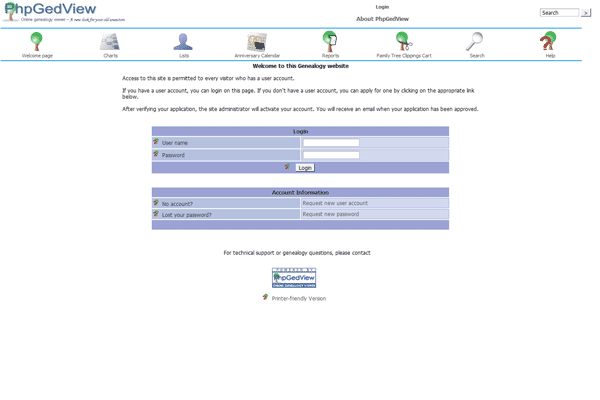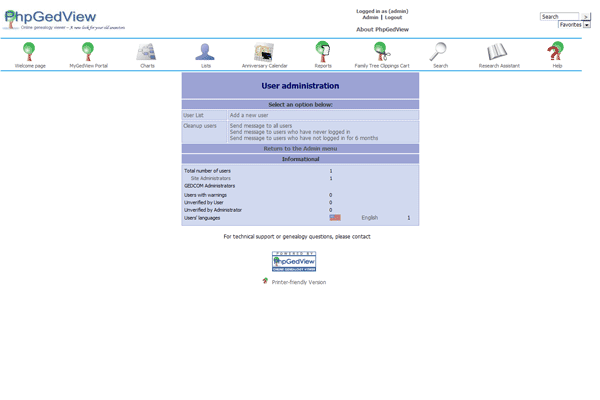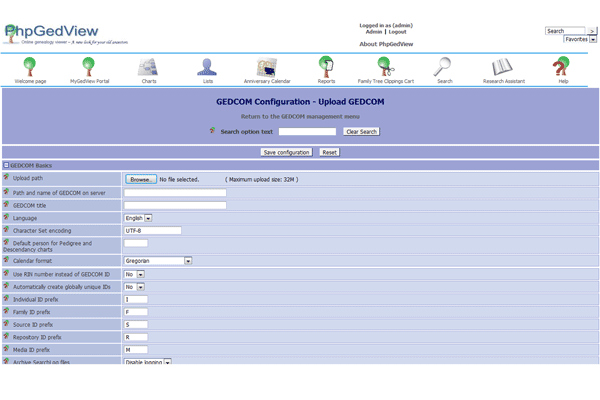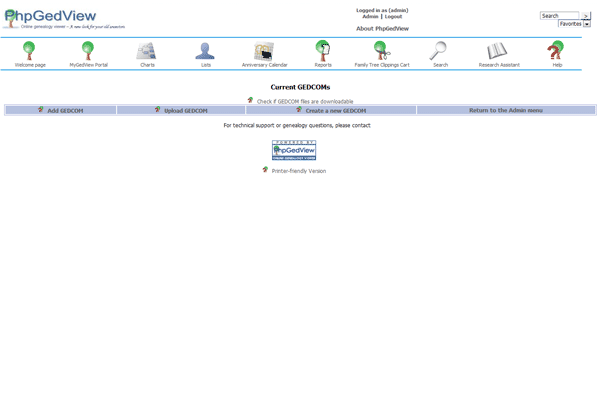1-click AWS Deployment 1-click Azure Deployment
Overview
PhpGedView is an open source application that lets you post your genealogy records on your Web site. It has a lot of interesting features, and makes viewing and editing all aspects of your genealogy easy and fun.
PhpGedView is written in PHP and needs a database such as MySQL or PostgreSQL. To run it, you just need to download the zipped archive and extract the contents somewhere inside the document root of your Web server. Then you must create an empty database and point your browser to the directory where you extracted the archive. The configuration page should open, and you must enter some settings like the database name, username and password, and whether users can request an account. When you have filled all the fields, you’re almost done.
If you have already created a family tree with another application you can export it in GEDCOM format and upload that file directly. If not, you can store your family members in PhpGedView. When you select a person you can see and add the Close Relatives (wife, husband, and children). To add a new person into the system, select an already inserted one and click on Add Wife, Add Husband, or Add Child. After you’ve entered some relatives, you can reach any random person from any other by clicking through the Close Relative view, and you are sure that all the people are connected together. You can add an unlinked person from the administrator menu and then connect it to another, but it’s easy to make mistakes doing that or leave people disconnected.
For each person in the system you can add a tremendous amount of data: date and place of birthday and death, job, religion, and photos, just to name a few. Most of the data you insert can be used for statistical reports and diagrams. For example, you can see all the people alive in 1890, or display birthplaces with little flags on Google Maps.
Even if you have entered only people’s names in your genealogy database, you can still create a lot of interesting representations, including diagrams and charts showing the connections between people. For instance, there is the classical tree-like Pedigree Chart, or the Relationship Chart, where you can see the relationship between two people. If you want to print information, there’s a good selection of PDF reports available.
One of the most interesting features of PhpGedView is its ability to let Internet users have an account. This way anyone that you, the administrator, accepts can contribute to improving the genealogy records: adding new people, correcting mistakes, inserting birthdays, and so on. You can for instance add your family, then give an account to your uncle, who can add his family (maybe inserting some details you don’t remember). If you give an account to someone you don’t trust, you can specify that any changes he makes must be approved by an administrator before being visible online.
PhpGedView has also some privacy settings. If you don’t want everyone to be able to see your date of birth, for example, you can specify that people’s personal details are viewable only by registered users. There are also some display themes to choose from, and you can specify which languages are made available to users.
PhpGedView is not as user-friendly as you might like. This is particularly troublesome for ordinary users, such as relatives without a lot of genealogy knowledge. For example, adding the date of birth without using the provided JavaScript calendar can lead to little problems. If you enter it in a incorrect format (say 2007-08-01 instead of 01 Aug 2007) all seemes OK, but the date cannnot be used for statistical purpose and won’t be translated to other languages. If someone has made changes to the genealogy (added or modified people) that you have to review, there is a little link at the bottom of the page that the first time is not easy to find.Apart from these little flaws, PhpGedView is a great application. If you want to collaborate with others on researching your relatives, give it a shot.
PhpGedView is one of the leading PHP based genealogy software which allows you to view and edit your family tree on your website. PhpGedView has full editing capabilities as well full privacy protection functions. It supports multimedia like photos. There are several views of your genealogy which are available.Generation of pdf reports of your Descendancy as well as pedigree charts are also another highlight of this php based software. Though it runs on LAMP platform i.e. Linux, Apache web server, MySQL database and PHP, it can be configured to run on any webserver which supports PHP and MySQL.
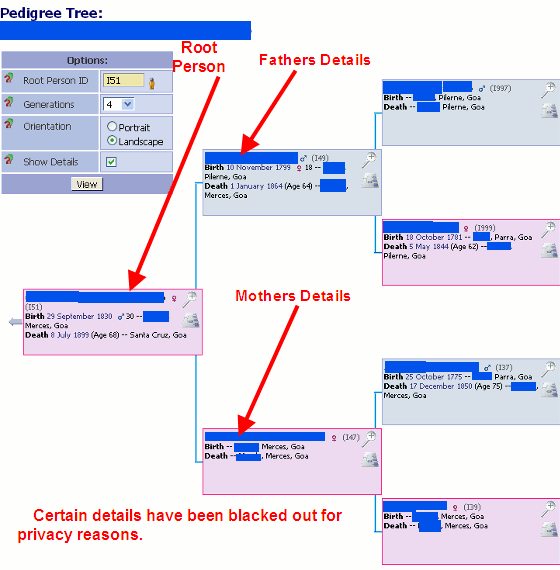
Menu Toolbar Options for PHPGedView
The toolbar for PhpGedView has a large array of settings. The main options are MyGedView Portal, Charts, Lists, Anniversary Calendar, Reports, Family Tree Clippings Cart, Search and Help.
Under the MyGedView Portal the logged in user can make changes to his account settings and the administrative user can Manage GEDCOMs and edit Privacy settings as well as admininister users and manage media files.
There is a large array of Charts in Php MyGed View software. They include Ancestry Chart, Circle Diagram, Compact Chart, Descendancy Chart, Family Book Chart, Hourglass Chart, Interactive Tree, Lifespan Chart, Pedigree Chart, Relationship Chart, Statistics and Timeline Chart.
The pedigree chart is one of the most popular charts in this software. It displays the relationship of an individual with his ancestors in an easy to understand format (See Screenshot above).

Clicking on an individual on any chart brings up the individuals details. It provides all the details of the individual including place of birth and date, occupation close relatives, notes and other special events. It also displays the concerned persons family with parents as well as spouse.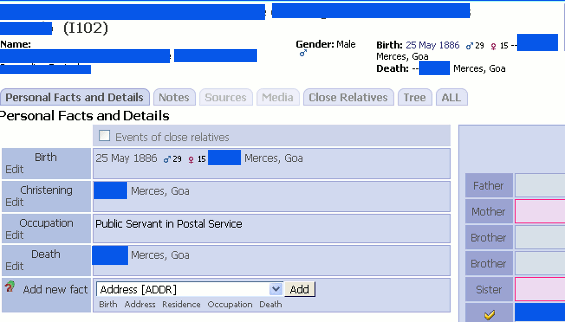 Hovering the cursor over any of the parent shows the grand parents names. Hover over the brother or sister or any childs column and you can see a list of their respective family.
Hovering the cursor over any of the parent shows the grand parents names. Hover over the brother or sister or any childs column and you can see a list of their respective family.
There is also a menu bar on the right on the individuals details page. This will help you get various reports connected with that individual. The complete overview is shown below.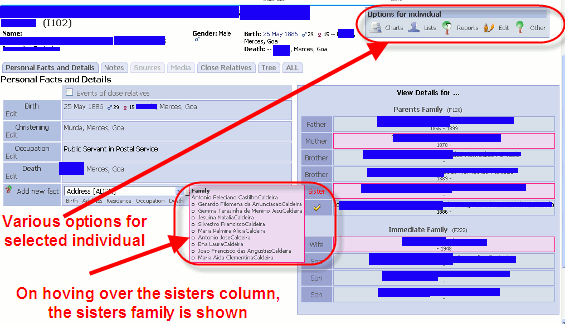
Lists, Aniversary Calendar and Reports for PHP Ged View
Under Lists there are comprehensive Family Lists as well as Individual List besides several others. The lists are alphabetical and you can filter the lists by persons dead, alive, alive in year, age greater than or less than 100, male, female etc.
The Anniversary Calendar gives the anniversary listings by Day View, Month View and Year View.
The Reports section contains a wide variety of reports like Address Labels, Address List, Birth Date and Place Report, Births, Deaths, Marriages, Death Date and Place Report, Descendancy Report, Expanded Relatives Report, Family Group Report, Individual Report, Marriage Date and Place Report, Pedigree Chart and Relatives Report.
Search and Help Options:
The search option enables you to search the database in various ways.The help section contains brief help as well as a wide variety of links to various help resources for Phpgedview.
PhpGedView manual installation:
System requirements:
PHP 5.2 or above
MySQL 4.1 or above
Manual Installation:
Download the package for PhpGedView from the official website:http://www.phpgedview.net/
– Upload the downloaded file to the public_html folder of your account using the File Manager in cPanel:
– Next you will need to extract the zip file:
– Now go to cPanel > MySQL Database Wizard and create the database to be used by the application. Write down the database name, username and password. Those will be needed during the installation process:
– Open your domain name in the browser. A requirements check is made:
– On the next step you will need to apply the database settings for the application:
– Next you are able to make changes to some application settings. In case that you are not sure what you need to change leave them as they are:
– Now you will need to apply the language settings for the application:
– On the next step you will need to apply the administrative login credentials for the application:
– Congratulations! Your PhpGedView application is successfully installed:
The Benefits of PhpGedView Hosting:
- Improvements to the external database structure, and a redesign of the internal data structures, for performance, flexibility and ease of maintenance.
- More options for statistics and charting.
- Improved multimedia handling.
- Support for three new languages: Slovenian, Romanian and Indonesian.
- Improved soundex searching for non-English languages.
-PhpGedView is a revolutionary genealogy program which allows you to view and edit your genealogy on your website. PhpGedView has full editing capabilities, full privacy functions, can import from GEDCOM files, and
LogIn
User Administration
Upload GedCOM
Current GEDCOMs
supports multimedia like photos and document images. PhpGedView also simplifies the process of collaborating with others working on your family tree. Your latest genealogy information is always on your website and available for others to see.
Features
PhpGedView Features include:
- Multi-user, platform-independent system, allowing for distributed work on a family tree.
- Several modes for protecting the privacy of data, such as protecting all data from unregistered users, or protecting data on living people from unregistered users.
- Several types of reports and diagrams can be produced.
- Export to PDF for viewing, storing and printing.
- Fully compliant with GEDCOM 5.5.
- Powerful searching features let users find the people they are looking for.
- Pedigree, Descendancy, and Timeline charts just like in a regular genealogy program.
- Customizable theme templates.
- Share your genealogy with your family, friends, and the world over the Internet.
- Edit your genealogy online.
- Allow your family members to login and view and/or edit genealogy online.
- Collaborate better with your family members by working together on the same data set.
- RSS feed.
- Supports output to GRAMPS XML file format.
- Extendable with modules including:
- Gallery 2.
- phpBB.
- Lightbox.
- Google Maps.
- Integration modules for content management systems.
-The Major Features Of PhpGedView:
- Improvements to the external database structure, and a redesign of the internal data structures, for performance, flexibility and ease of maintenance.
- More options for statistics and charting.
- Improved multimedia handling.
- Support for three new languages: Slovenian, Romanian and Indonesian.
- Improved soundex searching for non-English languages.
Videos
How to use PhpGedView


















